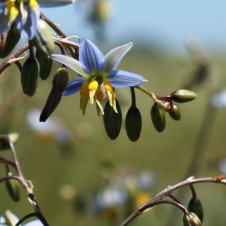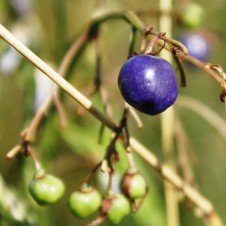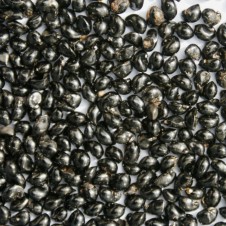General Description: Is a tufted matt-forming perennial lily. These loose mats can be up to 5 m wide, making it difficult to distinguish individual plants. Both midrib and margins of leaves have sharp, peg-like teeth. Flower stems are arching to 90cm tall and flowers have pale to deep blue-violet petals which bend backwards towards the stem.
Flowers and Fruit: The flowers are large, star-shaped, nodding and sweetly fragrant. Flowers from October to April. Fruit is a purple, round, fleshy berry, to 7 mm long.
Conservation:[E] Endangered in Australia. [e] Endangered in Victoria. Matted Flax-lily is listed as ‘Endangered’ under the Commonwealth Environment Protection and Biodiversity Protection Act 1999.
Site Preference and Tolerances: This plant is known to occur in lowland grasslands, grassy woodlands and grassy wetlands. It ranges from well drained to seasonally wet soils. Suits most conditions but flowers best in full sun and is drought hardy.
Life Span: Medium (20 to 80 years)
Wildlife Value: Fruit attracts a variety of birds, for example the Grey Shrike-thrush, Rosella, White-eared Honeyeater and Red Wattlebird. Also the Shingle Backed and Blue Tongue Lizards have been known to eat ripe berries. Patches provide habitat for ground-dwelling reptiles and small marsupials. Leaves are a favourite food of kangaroos that readily graze down the mats of this Dianella this promotes the production of new shoots making the mats cover a larger area.
Other Values and Uses: Retains green foliage and looks lovely in wildflower beds and rockeries. Aborigines used the berries for food and blue dye. Can be grown from seed or division and is useful for general erosion control.
Other Scientific Names: Dianella longifolia p.p.
Germination Information: Sow seed in late summer to early spring, this Dianella usually has good results. Soaking seed in soapy water (Velvet soap) may improve results.



